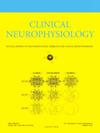广泛性焦虑障碍患者基于脑电图的源功能连通性改变
IF 3.7
3区 医学
Q1 CLINICAL NEUROLOGY
引用次数: 0
摘要
目的探讨广泛性焦虑障碍(GAD)的神经生理标志物,对广泛性焦虑障碍患者进行脑电图(EEG)检查,并评估迟滞相同步(LPS),一种衡量脑功能连通性(FC)的指标。方法采用精确低分辨率脑电断层扫描(eLORETA)对脑电脑源进行建模。将图论分析应用于LPS获得的无向和加权网络,探讨广泛性焦虑症患者与对照组之间的FC差异。检查异常参数与疾病症状之间的关系。结果与对照组(n = 89)相比,GAD组(n = 104)在左扣带回和右中央后回(PcG)之间的β -2 (18.5-21 Hz)和大脑半球之间的β -3 (21.5-30 Hz)中表现出更高的大脑连通性,特别是左PcG。广泛性焦虑症患者β -3的整体网络效率更高。最后,研究人员观察到,患病时间越长,大脑各区域之间β -2的FC含量越高,两者之间存在正相关关系。结论:目前的研究结果表明,脑电图来源的测量是了解广泛性焦虑症患者大脑连接改变的有用工具。脑电图可能是一种有价值的生物标志物,可用于区分广泛性焦虑症患者和对照组,并可能成为未来研究中潜在的预测工具。本文章由计算机程序翻译,如有差异,请以英文原文为准。
Altered electroencephalography-based source functional connectivity in patients with generalized anxiety disorder
Objective
To explore the neurophysiological markers of generalized anxiety disorder (GAD), we performed electroencephalography (EEG) in patients with GAD and assessed lagged phase synchronization (LPS), a measure of brain functional connectivity (FC).
Methods
Cortical EEG sources were modelled by exact low resolution brain electromagnetic tomography (eLORETA). Graph theory analyses were applied to undirected and weighted networks obtained by LPS to explore the FC differences between patients with GAD and controls. The association between the abnormal parameters and disease symptomatology was examined.
Results
Compared to controls (n = 89), the GAD group (n = 104) showed higher brain connectivity in beta-2 (18.5–21 Hz) between the left cingulate gyrus and the right postcentral gyrus (PcG) and in beta-3 (21.5–30 Hz) between the brain hemispheres in several regions, particularly the left PcG. Patients with GAD showed higher global network efficiency in beta-3. Finally, a positive correlation was observed between a longer duration of illness and greater FC in beta-2 between brain regions.
Conclusions
The present findings suggest that EEG-sourced measures are useful tools for understanding altered brain connectivity in GAD.
Significance
EEG could be a valuable biomarker in differentiating patients with GAD from controls and could be a potential predictive tool in future studies.
求助全文
通过发布文献求助,成功后即可免费获取论文全文。
去求助
来源期刊

Clinical Neurophysiology
医学-临床神经学
CiteScore
8.70
自引率
6.40%
发文量
932
审稿时长
59 days
期刊介绍:
As of January 1999, The journal Electroencephalography and Clinical Neurophysiology, and its two sections Electromyography and Motor Control and Evoked Potentials have amalgamated to become this journal - Clinical Neurophysiology.
Clinical Neurophysiology is the official journal of the International Federation of Clinical Neurophysiology, the Brazilian Society of Clinical Neurophysiology, the Czech Society of Clinical Neurophysiology, the Italian Clinical Neurophysiology Society and the International Society of Intraoperative Neurophysiology.The journal is dedicated to fostering research and disseminating information on all aspects of both normal and abnormal functioning of the nervous system. The key aim of the publication is to disseminate scholarly reports on the pathophysiology underlying diseases of the central and peripheral nervous system of human patients. Clinical trials that use neurophysiological measures to document change are encouraged, as are manuscripts reporting data on integrated neuroimaging of central nervous function including, but not limited to, functional MRI, MEG, EEG, PET and other neuroimaging modalities.
 求助内容:
求助内容: 应助结果提醒方式:
应助结果提醒方式:


